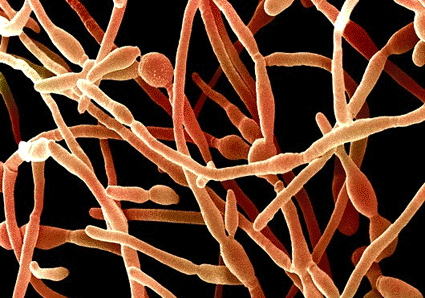Hypertonic Culture Medium Differentiates Fungal Species
By LabMedica International staff writers
Posted on 11 Apr 2011
A hypertonic glucose agar has been used for phenotypic characterization of two Candida species following molecular classification. Posted on 11 Apr 2011
Isolates of Candida dubliniensis and C. albicans were distinguished as species by growing them on hypertonic Sabouraud glucose agar (SGA) with 6.5% sodium chloride.

Image: Scanning electron micrograph (SEM) of Candida spp. (Photo courtesy of D. Phillips / Science Photo Library).
Scientists at the University of Delhi, (Delhi, India), tested the SGA method on 84 isolates of C. albicans, 18 of C. dubliniensis, and 2 reference strains. Of the test C. albicans isolates, 41 originated from the oropharynx of 27 human immunodeficiency virus (HIV) positive patients and the rest from 41 patients with lung diseases. Identity of the test fungi was based on their typical phenotypic characteristics and confirmed by a diagnostic polymerase chain reaction (PCR), that targets the novel C. dubliniensis group I intron in the large ribosomal subunit.
All of the 84 test and 2 reference C. albicans isolates grew on hypertonic SGA, while, in strong contrast, none of the test and reference C. dubliniensis isolates exhibited any growth up to seven days of incubation. Of the 84 C. albicans isolates, 77 (91.6%) inoculated on hypertonic SGA showed growth at 72 hours of incubation and the remaining seven at 96 hours. On Staib agar, 19 of the 20 test C. dubliniensis isolates showed chlamydospore formation at 48 hours of incubation and the solitary remaining isolate at 96 hours. In comparison, most C. albicans isolates did not grow well on this medium. Growth inhibition at 45 °C was observed by all of the test and reference C. dubliniensis isolates. However, growth inhibition also occurred in a large majority of the C. albicans isolates at this temperature indicating poor specificity.
The authors concluded that their observations are highly significant in that hypertonic SGA with 6.5% sodium chloride was entirely free from any false positive or false-negative results. The hypertonic SGA was strongly recommended for wider application as a reliable and inexpensive medium for routine differentiation of C. dubliniensis from C. albicans. The study was published online on March 9, 2011, in the journal Diagnostic Microbiology and Infectious Disease.
Related Links:
University of Delhi




 assay.jpg)








